Last Updated on 29 July 2025 by Greg Brookes

Kettlebell exercises are one of the safest, most effective ways for seniors to stay strong, balanced, and independent. Whether you’re in your 60s, 70s, or beyond, the right kettlebell moves can help you lift more confidently, improve posture, and move with less pain.
In this guide, I’ll walk you through the best kettlebell exercises for seniors, along with a simple circuit to get started.
Want a full weekly routine? Visit my Kettlebell Workouts for Seniors for complete training plans.
How do kettlebell exercises help seniors
Kettlebell exercises when performed correctly can be an effective way for seniors to exercise at home.
Kettlebell training requires minimal equipment, just a few kettlebells, and very little space.
However, the results that can be achieved from just using kettlebells a few times per week can be significant.
Seniors exercise benefits of using kettlebells:
- Increases bone density due to the additional forces put through the joints and bones by the kettlebells
- Adds muscle mass, something that you lose quickly as you reach older age
- Improves balance, great for preventing falls and better footing
- Increases grip strength, another attribute that disappears quickly as you get older
- Improves mobility, nothing symbolises old age like an inability to move naturally
- Rehabilitates joint issues, the frequent nutritional pumping movements of kettlebell training improves joint health
- Improves circulation, kettlebell training actively pumps the blood around the body for better circulation
- Increases cardiovascular health, your heart rate will be elevated and lungs forced to work harder
- Raises metabolic rate for fat loss, an increase in metabolism means more calories burnt at rest
- Increases confidence, feel stronger, mobile, fitter and have better balance for a more confident you
- Improves mental health and produces a more positive attitude towards life in general
Are kettlebells safe for seniors
As mentioned earlier age is not always the best indicator of good health and fitness.
Some seniors are strong, flexible, and have great cardio.
As with all exercise you should check with your doctor first and take it steady.
If you have high or low blood pressure or heart issues then you need to be careful with overhead movements that challenge the heart.
Be careful with certain kettlebell exercises that challenge your balance. Try to exercise near something that you can hold onto and have the room to get out of the way if necessary.
Be aware of any medication that you may be taking. Could you feel dizzy or drowsy all of a sudden?
Ultimately, we should all be fit and healthy and be able to move pain free. Using regular exercise is the solution to a happier and healthier life.
Kettlebell weights for seniors
Your focus as a senior should not be to break any lifting records or to push yourself to complete exhaustion.
You should also realise that you are stronger than you think and without adding load to an already strong body will not give you the stimulus that your body needs to improve.
So you need to take a look at your previous experience of lifting weights.
Do you or have you had a physical job that has left you stronger than most or do you have zero experience of weight lifting.
I always recommend that the average man start with a 12kg (26lbs) and woman an 8kg (17lbs).
You can reduce this weight for some exercises and increase it for others.
Learn more: Complete guide to buying the correct kettlebells
Start with a full body mobility warm up
One of the most important aspects of your health that you should work on as you age is your joint mobility.
As you get older and move less you ability to take your joints through their full range diminishes.
A lack of joint mobility will not only affect your posture but also your ability to move correctly.
So stay young and learn to mobilise your joints as often as possible.
I recommend that you run through a full joint mobility routine before each workout.
For many people this mobility routine can have more of an impact on their lives than the workout so please don’t skip this section.
1. Neck mobility warm up for seniors
The neck or cervical spine is inherently connected to the shoulders.
If you suffer from headaches, neck issues or even shoulder problems then it’s important to free up and mobilise the neck.
The great thing about neck mobility is that you can practice anytime of the day even while seated watching TV.
Watch a video of the neck mobility warm up exercises below:
2. Shoulder mobility warm up for seniors
The shoulder joints are connected with the upper back as well as the neck.
Too much desk work and sitting can cause a rounding of the shoulders and limited mobility in the shoulder joints.
Shoulder joint mobility is important to pump nutrients into the joints that will help heal any shoulder issues that you may be suffering from.
Watch a video of the shoulder mobility warm up exercises below:
3. Upper back mobility warm up for seniors
The upper back or thoracic spine is one of the areas that is getting more and more restricted with modern lifestyles.
A lack of joint mobility in the thoracic spine will cause an overuse of the shoulder joints as well as the lower back.
If you only have time to mobilise one area of your body then this is the place to focus your attention.
Watch a video of the upper back mobility warm up exercises below:
4. Wrist mobility warm up for seniors
Using kettlebells will require the wrist to work hard to maintain balance of the kettlebell.
Regular wrist mobility will help keep the joints healthy and improve circulation.
Watch a video of the wrist mobility warm up exercises below:
5. Hip mobility warm up for seniors
If you don’t walk over varied ground or take part in sports then your hip mobility will probably be limited.
Poor hip mobility will affect your walking gait as well as force your lower back to move more than it should do.
An inability to move the hips correctly will also create additional compensations in the knees leading to potential knee issues.
Watch a video of the hip mobility warm up exercises below:
6. Knee mobility warm up for seniors
Being able to fully bend the knee joint is important for daily life.
Simple bodyweight squats are one of the best exercises you can perform and will strengthen your full body.
Watch a video of the knee mobility warm up exercises below:
7. Ankle mobility warm up for seniors
Good ankle mobility will improve your balance as well as prevent further leg injury while walking or tripping on uneven ground.
Often one of the most overlooked areas of the body a simple ankle mobility routine will also improve circulation.
Watch a video of the ankle mobility warm up exercises below:
7 kettlebell exercises for seniors and older adults
Below I have listed 7 kettlebell exercises for seniors which I believe build a solid and effective foundation for seniors.
Above all else take your time and listen to your body.
1. Kettlebell Slingshot
(See full breakdown in: Kettlebell Slingshot)
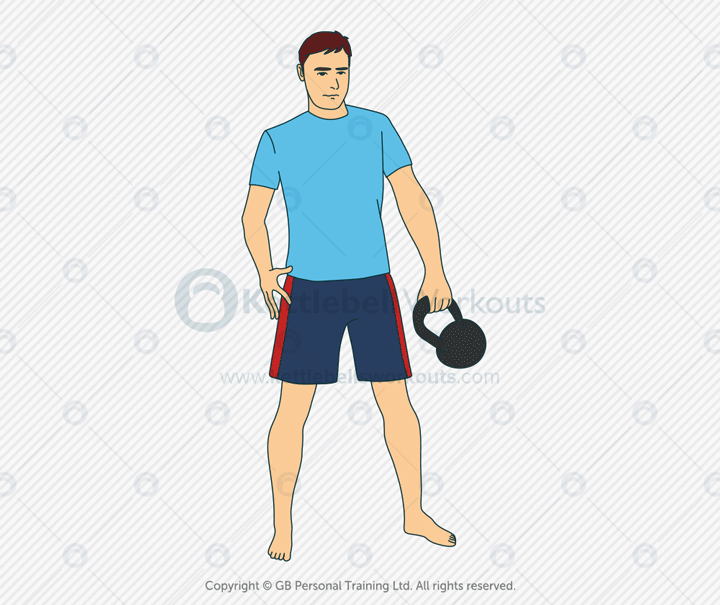
The kettlebell slingshot will help improve your grip strength, mobilise your shoulder joints and strengthen your core muscles.
The slingshot is one kettlebell exercise that I recommend everyone practice.
Try to stay as upright as possible throughout the exercise and keep the hips nice and still.
Practice: work up to 20 repetitions in each direction
Watch a video of the kettlebell slingshot exercise below:
2. Kettlebell Halo
(See full breakdown in: Kettlebell Halo)

The kettlebell halo is a good exercise for seniors with limited mobility as it helps to open up the shoulders and upper back.
The halo can be a difficult exercise if the weight is too heavy so practice with a lighter kettlebell, weight plate, or medicine ball.
Try to keep the kettlebell close to the neck line and don’t bend the head forwards.
Practice: progress slowly to 10 repetitions in both directions
Watch a video of the kettlebell halo exercise below:
3. Kettlebell Single Arm Deadlift
(See full breakdown in: Kettlebell Single Arm Deadlift)
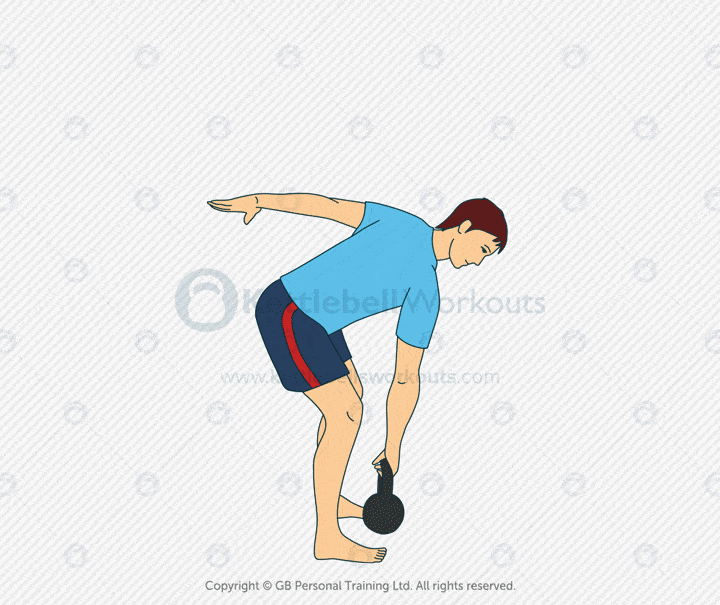
Whenever you pick something heavy up off the floor then you should be using the kettlebell single arm deadlift.
You will get big full body muscle activation from this exercise as well as training your body to move more effectively.
The single arm kettlebell deadlift is a good exercise for seniors with bad knees as you don’t get a full knee bend with the movement.
Work hard to keep your back flat and use your buttocks and legs to perform the heavy lifting.
Practice: work up to 12 repetitions on both sides.
Watch a video of the kettlebell single arm deadlift exercise below:
4. Kettlebell Single Leg Deadlift
(See full breakdown in: Kettlebell Single Leg Deadlift)

The single leg deadlift is a challenging exercise but excellent for improving your overall balance and stability on one leg.
This is another good exercise for seniors with bad knees as the front knee doesn’t bend very much at all.
You will also find this is a great exercise for seniors with limited mobility as it lengthens the hamstrings and mobilises the hips.
I recommend practicing the exercise without a kettlebell first in order to master the movement.
Practice: when you can perform 6 good reps on each side without a kettlebell then you can start adding the kettlebell
Watch a video of the bodyweight single leg deadlift exercise below:
5. Kettlebell Step Ups
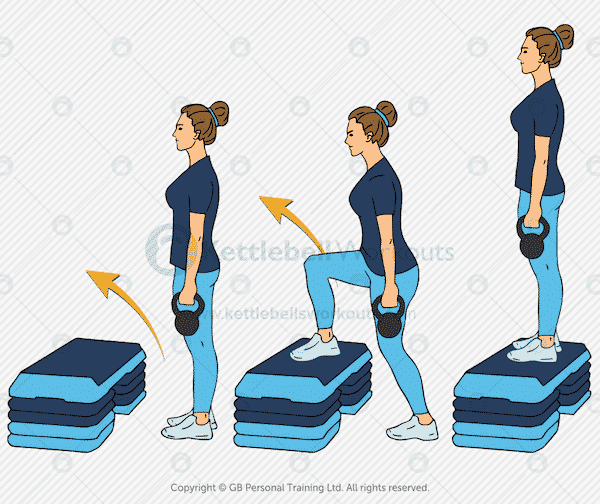
The kettlebell step up is a great exercise for seniors to strengthen the legs.
Not only is the kettlebell step up highly effective at raising the heart rate and strengthening the legs and buttocks but also has a great cross over into your daily life.
You will find walking up hills and stairs much easier if you work on this exercise.
The height of the step is very important, try to work on increasing the height so that the front thigh is parallel with the floor.
Try not to push off the back leg in order to step up, rather use the front leg to pull you up and onto the step.
The above image is shown with dumbbells but can be performed with ketlebells in each hand or in the goblet position as shown below in the next exercise.
Practice: start by alternating legs and work up to 20 repetitions. Next, work on just one side progressing to 12 each leg.
Watch a video of the kettlebell or dumbbell step up exercise below:
6. Kettlebell Goblet Squats
(See full breakdown in: Kettlebell Goblet Squat)
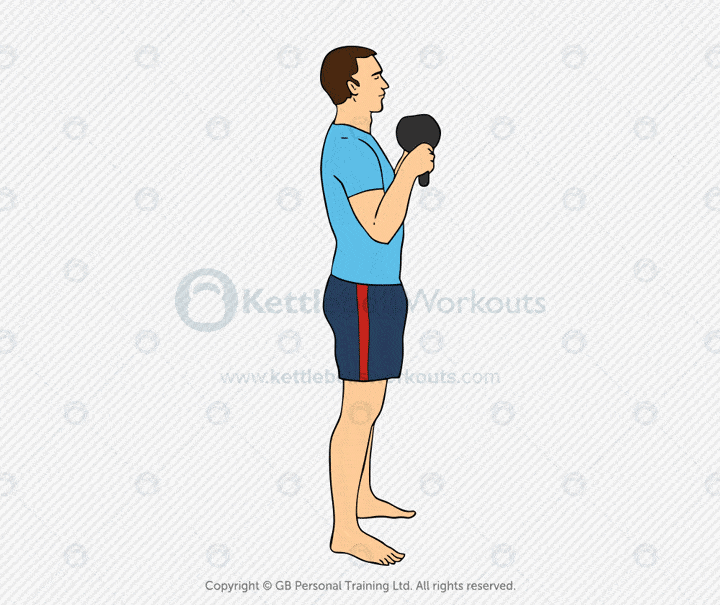
The kettlebell goblet squat is a very effective and important exercise.
There are not many muscles that the goblet squat doesn’t activate when performed correctly.
You will also quickly raise your heart rate, pump vital nutrients around your body and improve your movement strength and skills for daily life.
Beginners should practice the exercise without a kettlebell first before progressing to the kettlebell goblet squat variation.
Keep your chest up and heels down throughout the full movement. Failure to get a full 90 degree bend in the knees will limit the amount of buttock activation achieved.
Watch a video on how to improve your kettlebell goblet squat exercise below:
7. Kettlebell Turkish Get Ups
(See full breakdown in: Kettlebell Turkish Get-Up)
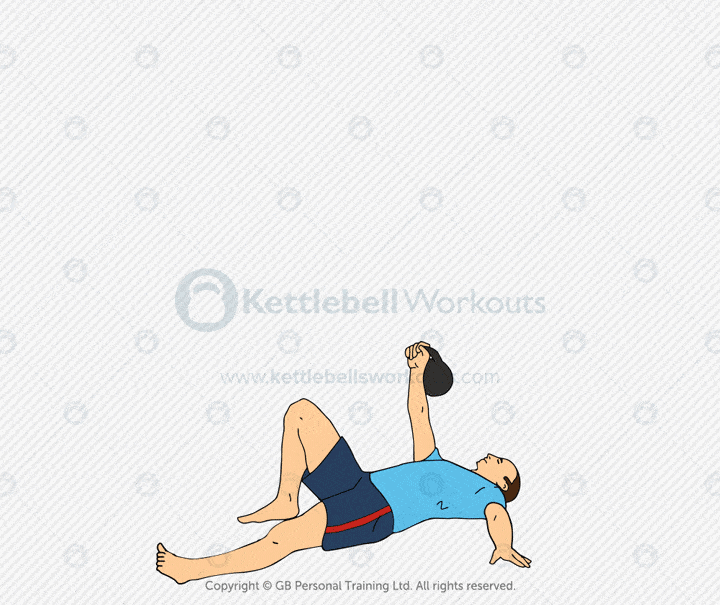
The kettlebell turkish get up is the most technical kettlebell exercise for seniors.
The ability to get up and down from the floor is an important activity as we get older and very challenging for many people.
The get up will mobilise all of your joints while improving your balance and stability in one exercise.
This is another important exercise for seniors with limited mobility.
Everyone should practice the get up without a kettlebell first, if need be you can hold a tennis ball or glass of water in the hand.
Practice: when you can perform 10 alternating repetitions without a kettlebell then slowly start to add some load.
Watch a video of the kettlebell turkish get up exercise below:
Looking for a complete training schedule using these moves? Head to my full Kettlebell Workout for Seniors post for a weekly plan with mobility and recovery built in.
How to use these kettlebell exercises for older adults
Now I have outlined what I believe to be the 7 best kettlebell exercise for seniors let’s look at how they can be combined into a workout.
Let me start by saying that you do not need to do all 7 kettlebell exercises for seniors.
However, you should be careful not to just perform the kettlebell exercises you enjoy and are good at.
Often it’s the exercises that we don’t do that are the ones we should do
Seniors Kettlebell Workout
- Single Arm Deadlift x 12 each side or Single Leg Deadlift (x 5 each leg)
- Slingshot x 10 each direction
- Goblet Squats (x 10) or Step Ups (x 10 each leg)
- Halo x 5 in each direction
- Turkish Get Ups x 1 each side
- Rest 60 seconds and repeat 1-3 times
You can perform the above kettlebell workout 3 – 4 times per week.
Start off steady and use a light kettlebell for the first 2 weeks before slowly increasing the load.
You should feel out of breath at the end of each circuit if not add more load or pick up the pace.
Final Thoughts
Kettlebell exercises for seniors are one of the most efficient ways to build strength, maintain mobility, and enhance confidence.
Start with mobility work, focus on foundational movements, and don’t rush progress. As your coordination and strength improve, your independence and quality of life will too.
Want complete programs? Check out my Kettlebell Workouts for Seniors or explore the full Kettlebell Exercise Library.
Curious how kettlebells can support you through every stage of life? Discover more personalised kettlebell training options in our all-in-one guide.
Frequently Asked Questions
Yes. With proper instruction, mobility prep, and a focus on foundational movements like deadlifts and squats, seniors over 60 can begin kettlebell training safely, even with no prior experience.
Most seniors benefit from 2–4 sessions per week, allowing time for rest and recovery. Consistency, not intensity, is key to long-term progress.
Step ups, single leg deadlifts, and suitcase carries (if included) are excellent for improving balance and stability. These movements train the body to remain steady during real-life activities.
While a trainer can help with form, many seniors successfully learn kettlebell basics at home using trusted online programs that include video demos and clear progressions.

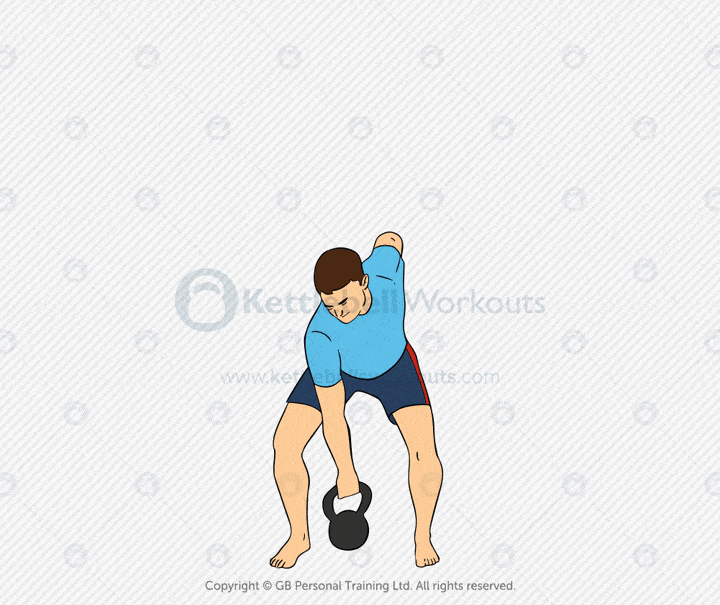


Hello,
Are you able to write individual programs for people?
Do you train folks over zoom?
Thank you
I am rehabbing my right knee that I injured with burpees that were too enthusiastic. It’s getting better, but was never 100%. Yesterday, I found this workout along with your blog How to Fix Bad Knees. I did a complete warmup, incorporating your warmup moves with the Intu-Flow warmup that Scott Sonnon has on YouTube.
I haven’t done Turkish Get-Ups in probably a year, so I practiced before doing the workout. After warmup and practice, I did three sets of the workout using a 4kg kettlebell for everything except the Turkish Get-Up, which I did with no weight. I felt great after the workout and today, my knee is much better with more flexibility and mobility and no pain. I had a bit of edema on the knee and did some dry brushing, which eliminated most of the swelling. I plan to continue doing this workout and will be adding in others.
Hi Greg,
Thanks for the kettlebell primer, it is much appreciated. I’ve been following your recommendation for about a year now with 15 and 20 weights. Is twice week sufficient to maintain strength or should I stick with every 2 day?
Thanks again,
……. john
P.S. I’m 79 years old.
Good to hear from you John, yes at 79 if you can perform 2 x full body workouts per week, eat well and just stay active then you are doing well.
I was surprised to NOT see the Kettlebell Swings on the list. Are those okay for older folks?
Hello Keith, yes Swings are great but you first need to master the other deadlifts on this list (to get your hinge right) in order to ensure you avoid injury as swings are very aggressive.
Just downloaded the APP, there are great workouts for a beginner like myself, through to advanced with good graphics.
Great Vids
Hello Greg, I’m happy to have found your workouts and videos. I’ve got very bad knees, and I cannot really perform squatting our lunging movements. Are there other kettle bell exercises I could perform that generally work the same muscle groups? Thank you so much 🙂
Thanks Timi, yes I’ve listed a few alternatives to lunges here
Greg, what is your opinion of the Bowflex SelectTech 840 Kettlebell? I am 75 years old, reasonably fit for my age (rowing machine, dumbbells, Nordic pole walking, etc.) and rather like the idea of being able to easily select from a variety of weights, starting light to get into it, without having to have a whole collection of kettlebells. My wife might also be interested as well.
I’m not familiar with this range of kettlebell Ben but you have to be careful with adjustable weights because the handles don’t tend to rest very comfortably against the arm during the racked position making cleans and many other exercises difficult. They should be OK for basic deadlifts and swings though.
Hi Greg:
I have been doing the two handed swing for years, but had no idea what else I could do with KB. thanks so much for these videos and lessons. They are a sorely needed resource to improve my strength and mobility.
Always enjoy your messages…especially for seniors…I’m an 83 wear old kettlebell/bodyweight instructor with 14 versions of my class…including a mobility warm up with a stretching cool down…keep ‘em coming…
Hi Greg,
I’m 76 and have been lifting free weights for years. Lately though I’ve been thinking that I should incorporate some cardio into my routine and am thinking that a good kettlebell routine would serve both functions. What are you thoughts?
Thanks,
…… john
Thanks Greg. You’re an excellent instructor.
………. john
This is exactly what I’m looking for, thanks for such a great piece!
Thank you for sharing your
knowledge of how to exercise with kettlebells!
:LOL! Hi Greg! I’m having a DICKENS of a timede! I am a female. Age 60. Overweight. But I can ROCK goblet squats and KB swings…and was hoping to “turn on” some older-than average neighbors…but do you realize — THERE ARE HARDLY ANY IMAGES on the ‘net that shows an OLDER PERSON!?!? Y’all are KIDS! LOL! I’d love to see some grey-haired gal or guy doing the routines…it can be so DAUNTING to encourage people my age to…TRY! Before it’s “too late!” Thanks for reading this. Just pointing out a NEED on the ‘net right now! Yours, Sonny
Greg, what I find very useful about your presentation is your specifying what weights to use. I am 71 and discovered kettlebells as recently as last year. I now have a collection of 8 kg, 12 kg, 16 kg and 20 kg. I have tried to develop a program with exercises appropriate for each of these weights. For example, I use the 20 kg only for singlehanded slingshots, two-handed dead lifts and two-handed swings. I also have a 9kg double-handed kettlebell which I bought without really thinking how I would use it. Are there any exercises you would recommend for that?
Hello Ken, check out: what kettlebell weights to use for different kettlebell exercises, I think it will help you.
Question! Do the suggested weights of 26 & 35 pounds, for men, still apply for Seniors?
It will depend on your previous experience with lifting weights Keith, if in doubt always start lighter and build up.
I’ve. had Kettle Bells for some time , without really knowing how to use them . Now I do , thank you !
Hi Greg just been looking at your video’s for seniors, I’m 66 quite fit from running and doing some resistance exercise on a vibration trainer. I have just ordered a 12Kg kettlebell and am looking forward to trying out your exercises for seniors so that I can improve my strength and balance. Will find your video’s invaluable,
Thanks, Rees.
I’m 65 and I loved the mobility exercises. Thank you so much! It was just what I needed to start getting flexible again!😊
I bought a kettlebell about 10 years ago and have never used it. Now I am 72 (next month) and tomorrow AM I will begin (with the warm up first, of course) doing these kettlebell workouts for seniors. I am looking to strengthen my core and bones and will be continuing the so far successful weight loss program I started in January. I was sure to obtained my doctor’s approval first.